Strategies used by undergraduate Englishmajored students in oral communication
Communication strategies (CSs) play a significant role in enabling EFL students to achieve a higher level of English proficiency and good ability in oral communication. Helping both EFL teachers and students gain awareness of CSs is essential in the Vietnamese context. This study, therefore, aimed to explore the most commonly used strategies in English oral communication among English-Majored students at Ho Chi Minh City University of Technology (HUTECH), Vietnam. Two instruments were employed to collect both qualitative and quantitative data, namely (1) the questionnaire and (2) the focus group with the participation of 213 English-majored sophomores, juniors and seniors. The findings of the study revealed that the most commonly-used speaking strategies are ‘fluency-oriented’, ‘message reduction and alteration’, and ‘negotiation for meaning while speaking’, and that the students used achievement strategies more often than reduction ones; and the most commonly-used listening strategies are ‘negotiation for meaning while listening’, ‘non-verbal’ and ‘scanning’. The findings also revealed that there are no significant differences in the use of CSs among the three academic levels of students. It is expected that the findings of the study would partly contribute to the enhancement of communicative competence (CoC) and the use of CSs among students at HUTECH in particular and at the Vietnamese tertiary level in general
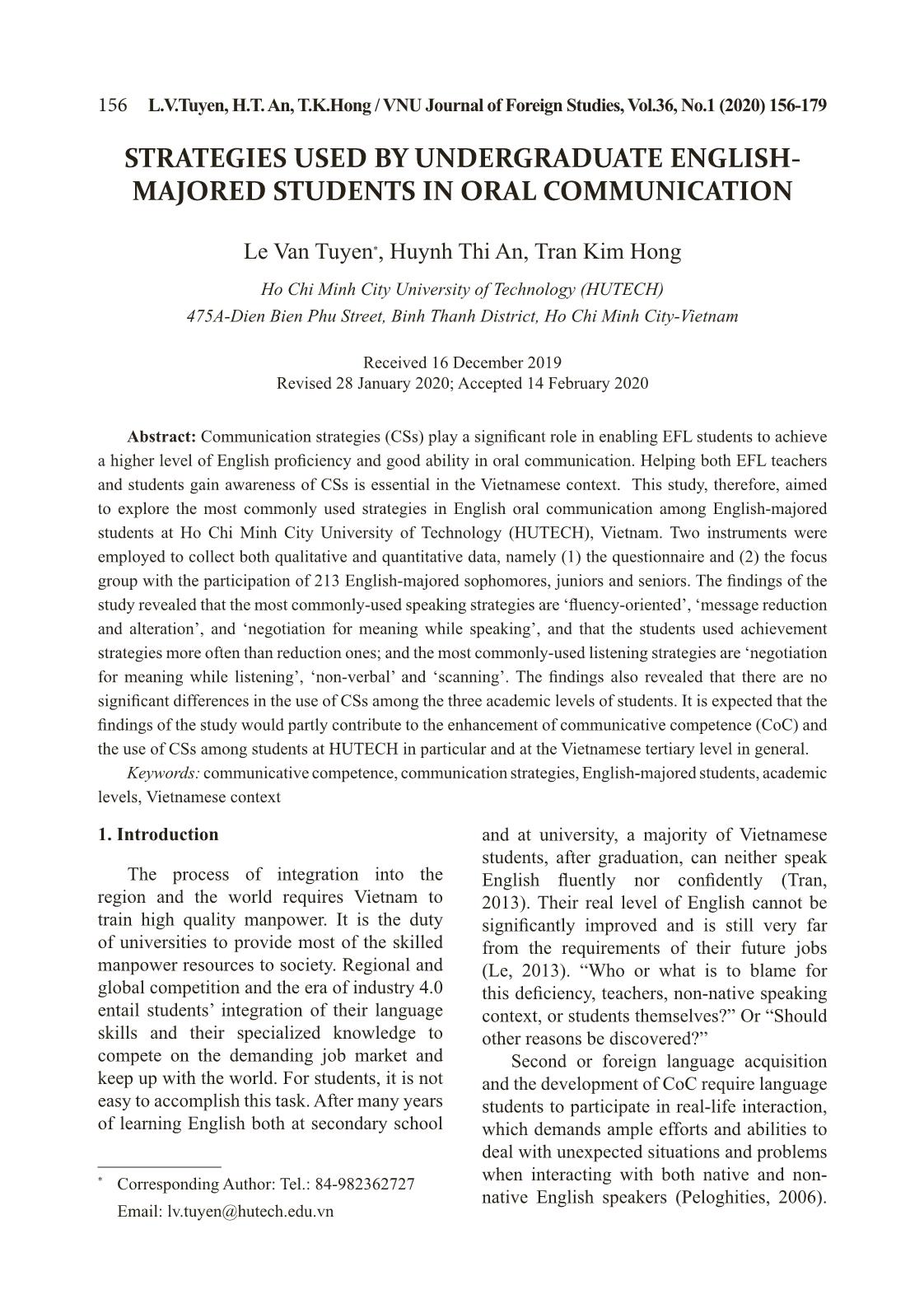
Trang 1
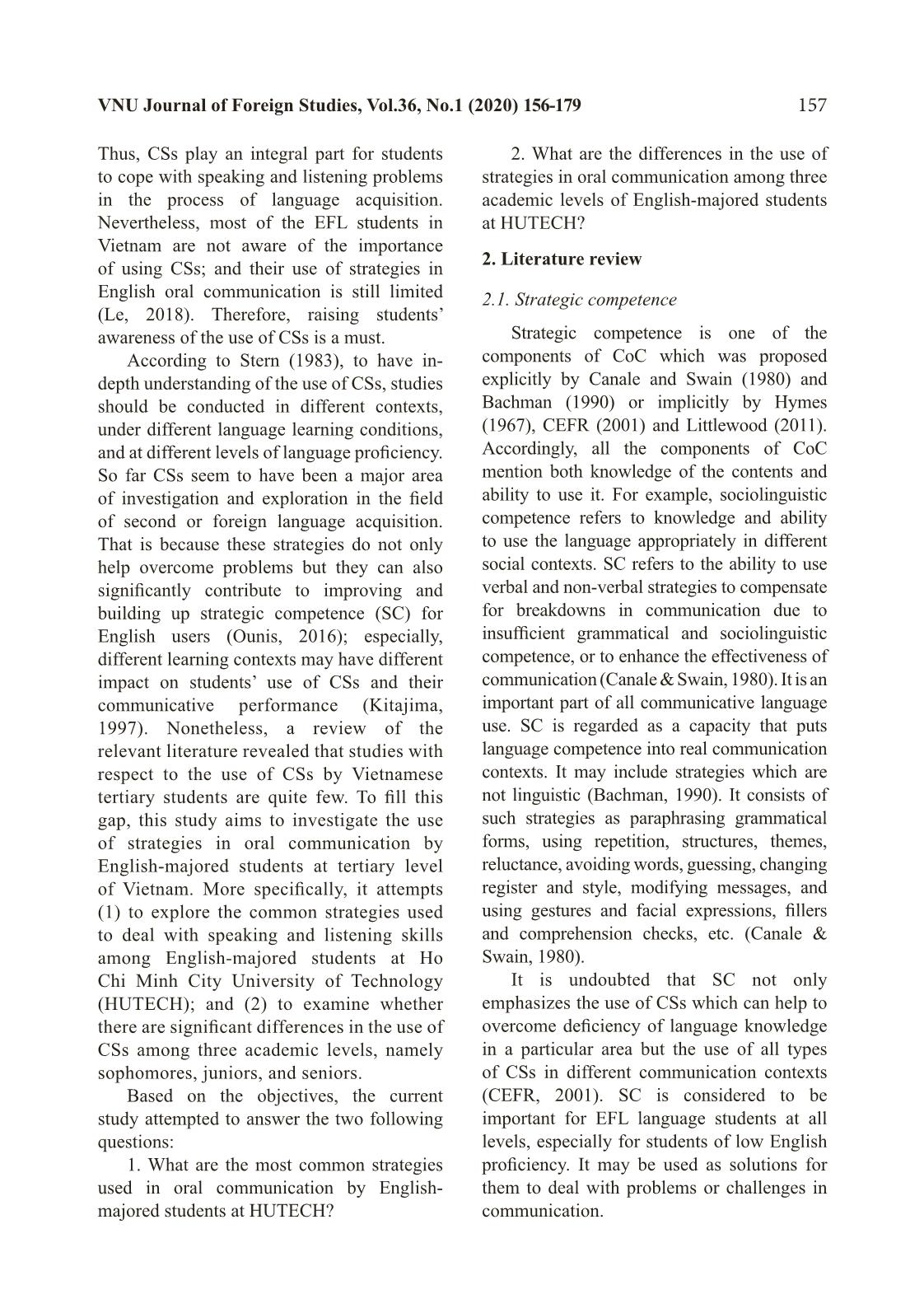
Trang 2
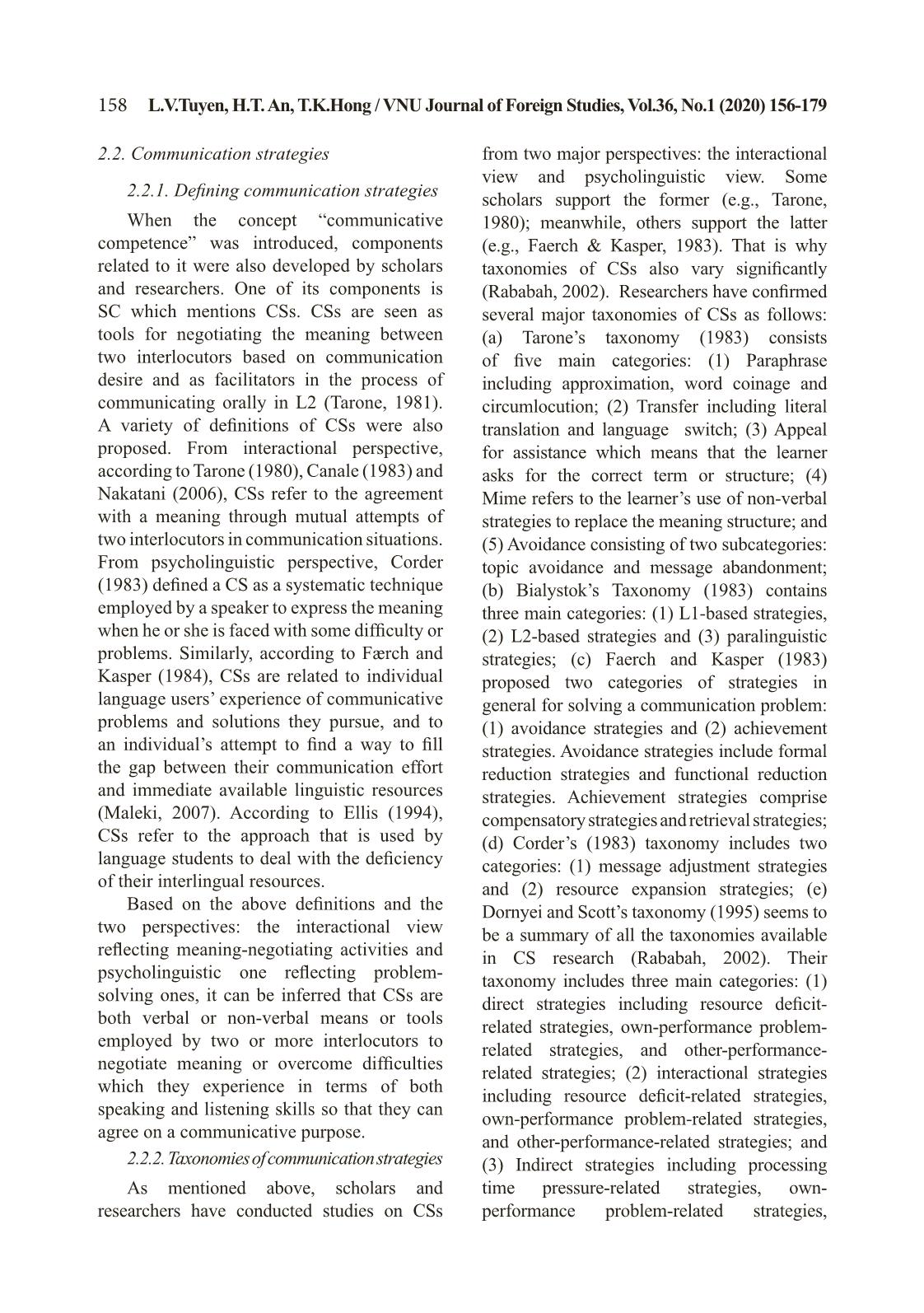
Trang 3
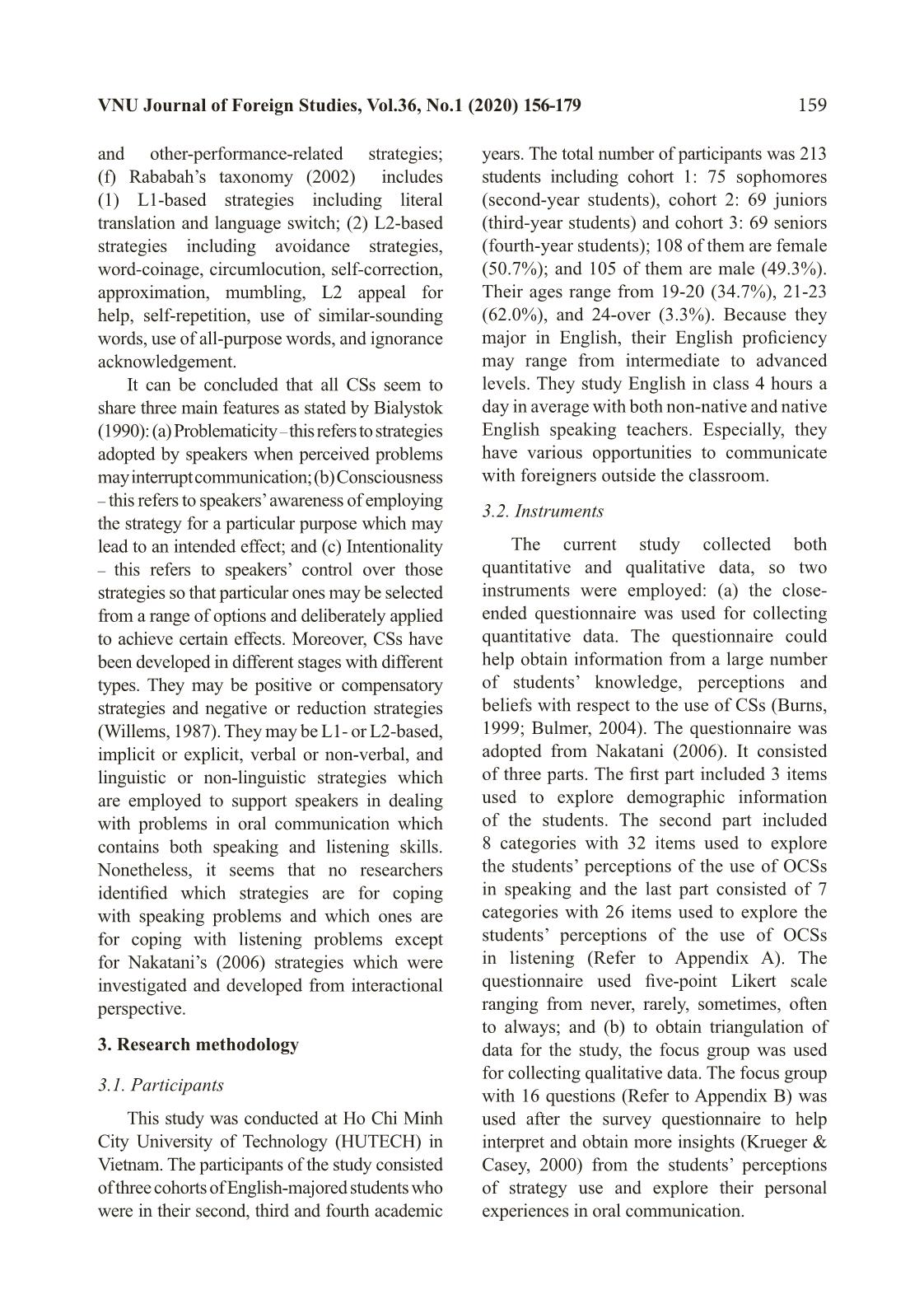
Trang 4
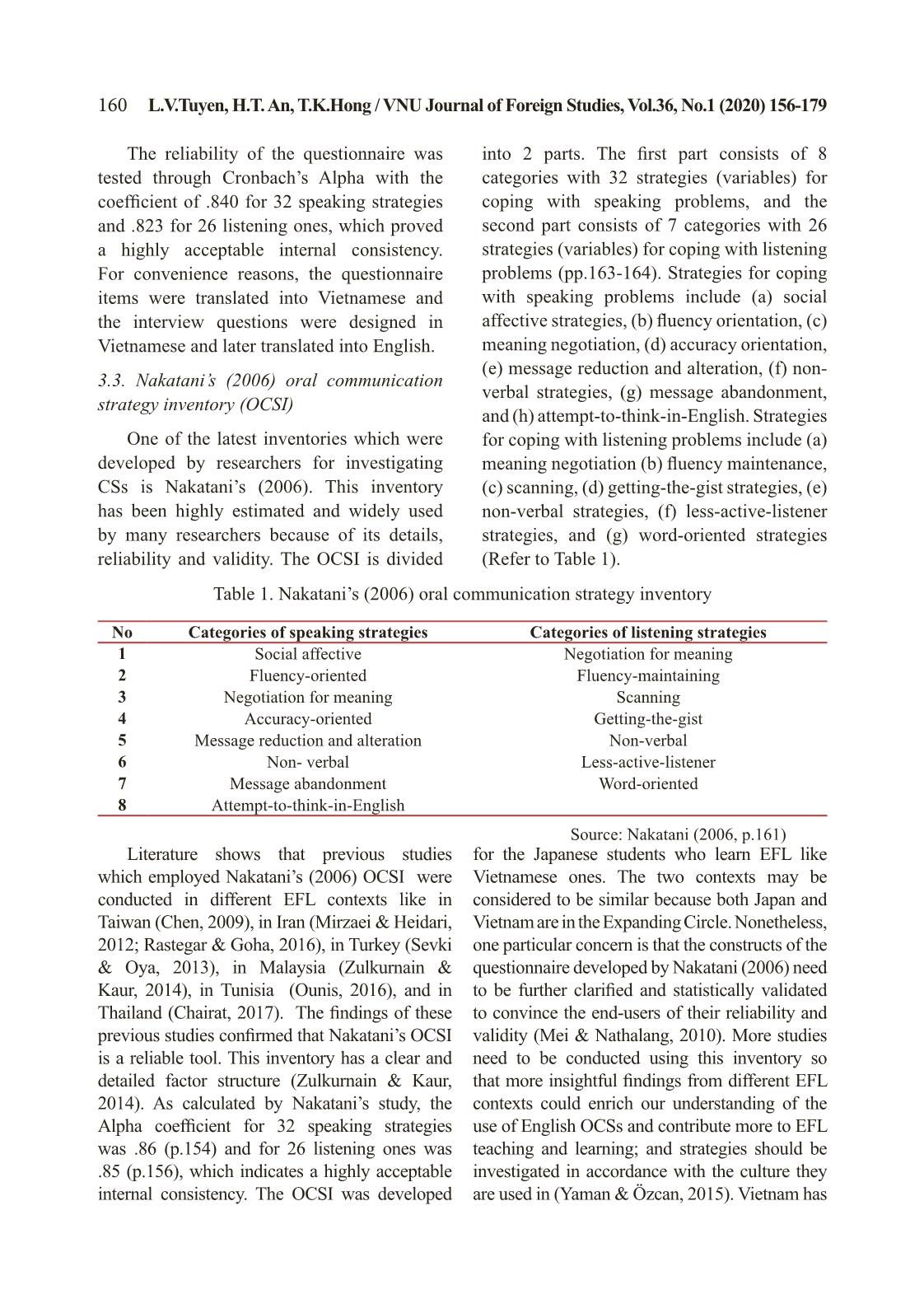
Trang 5
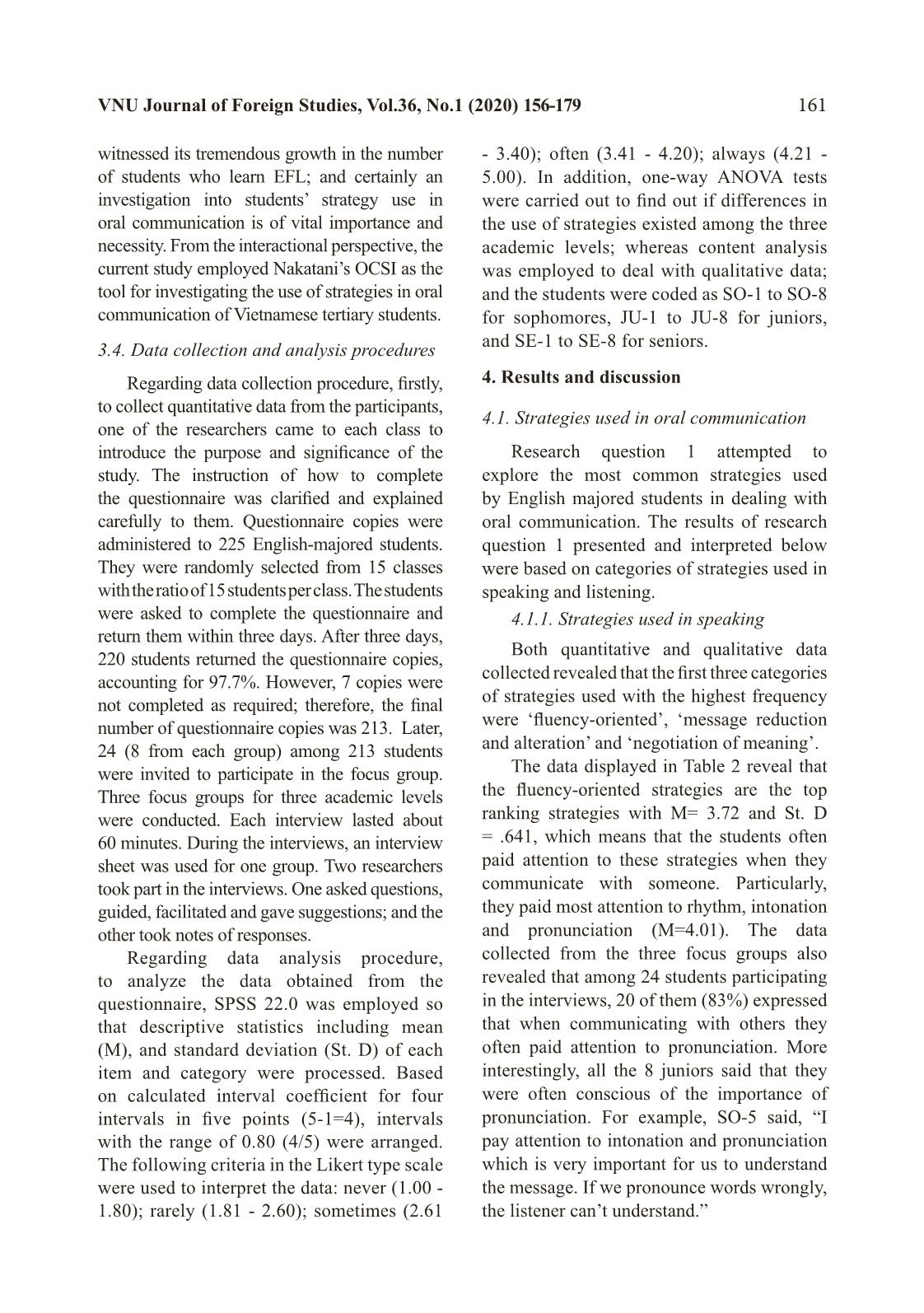
Trang 6
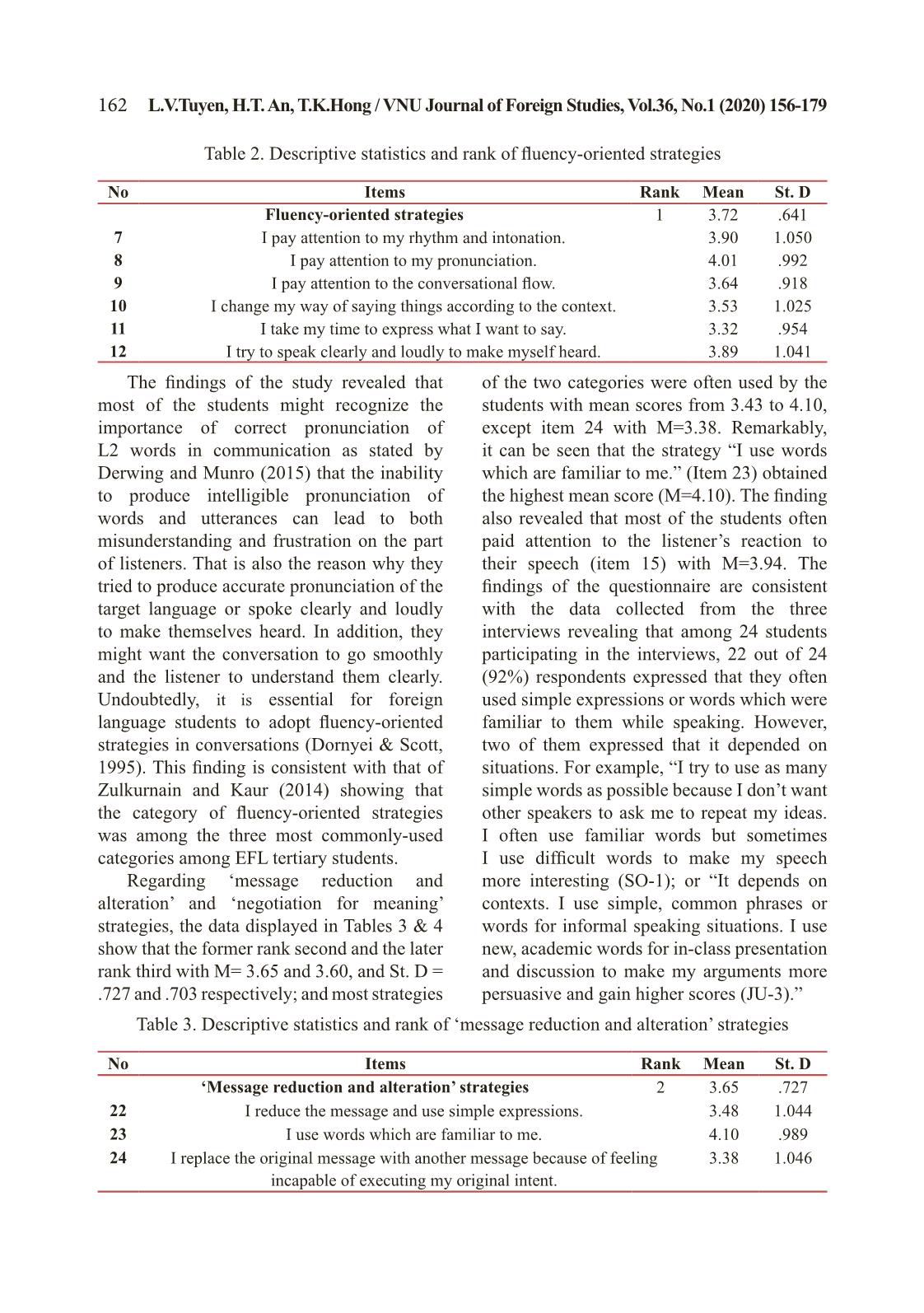
Trang 7
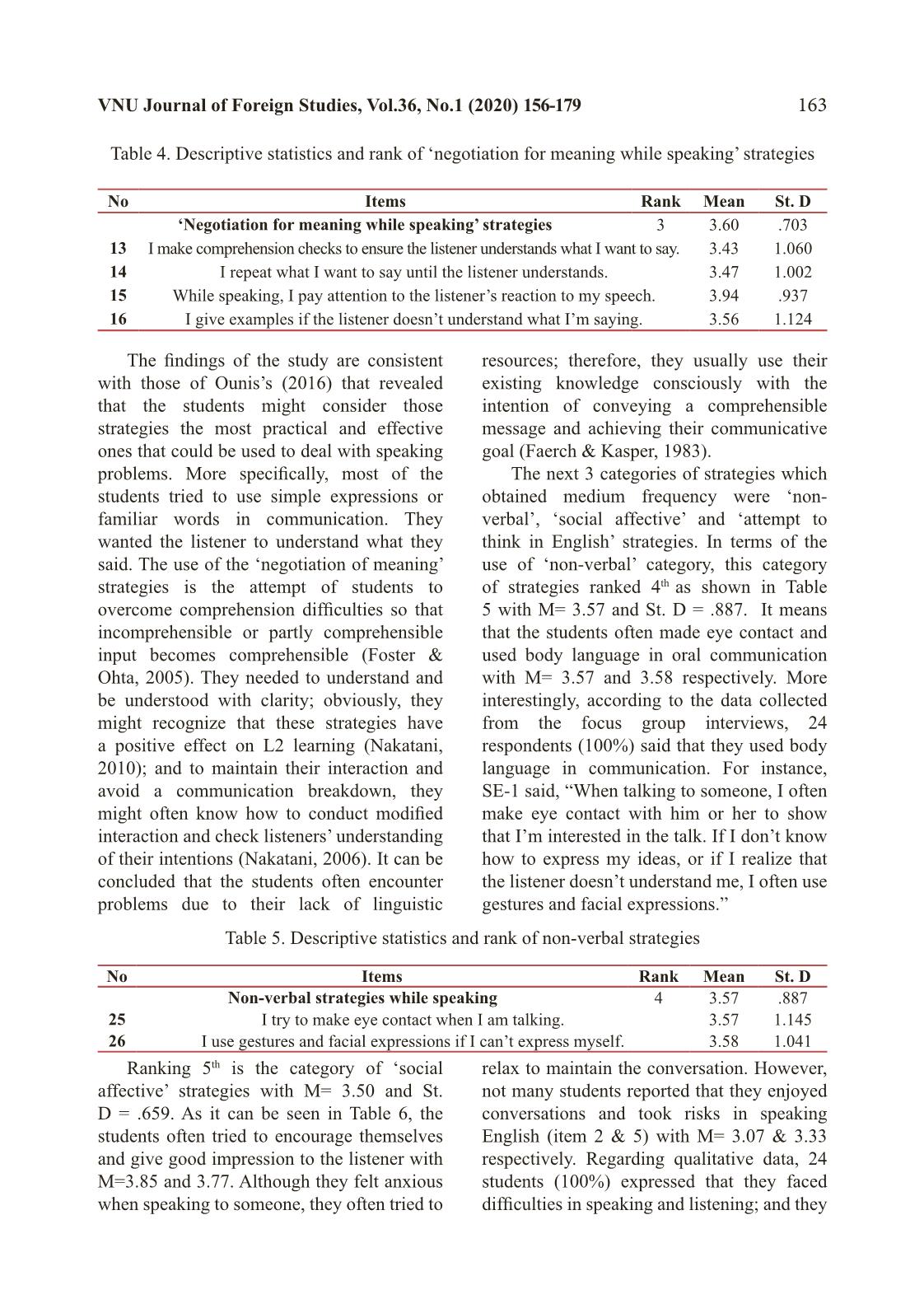
Trang 8
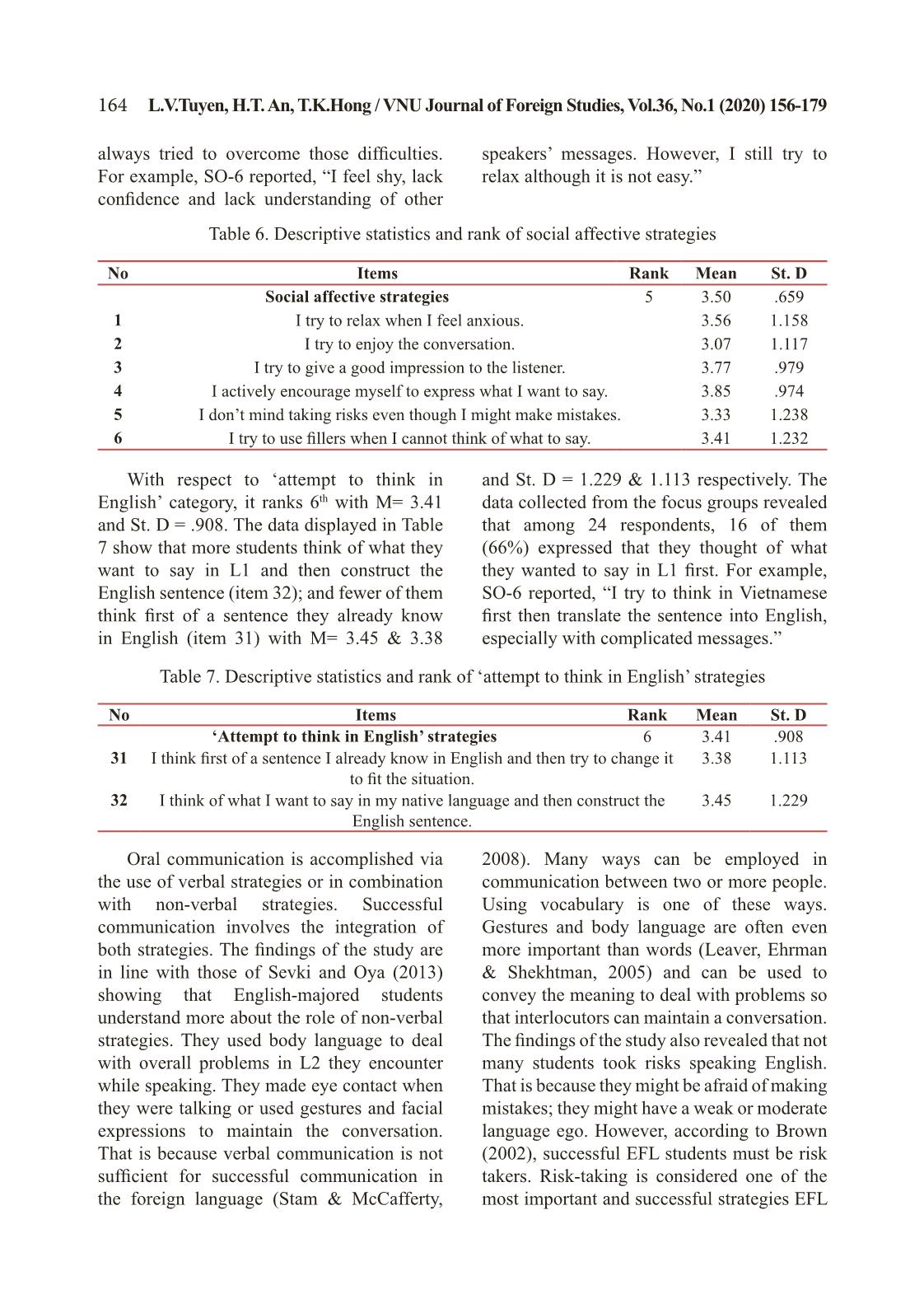
Trang 9
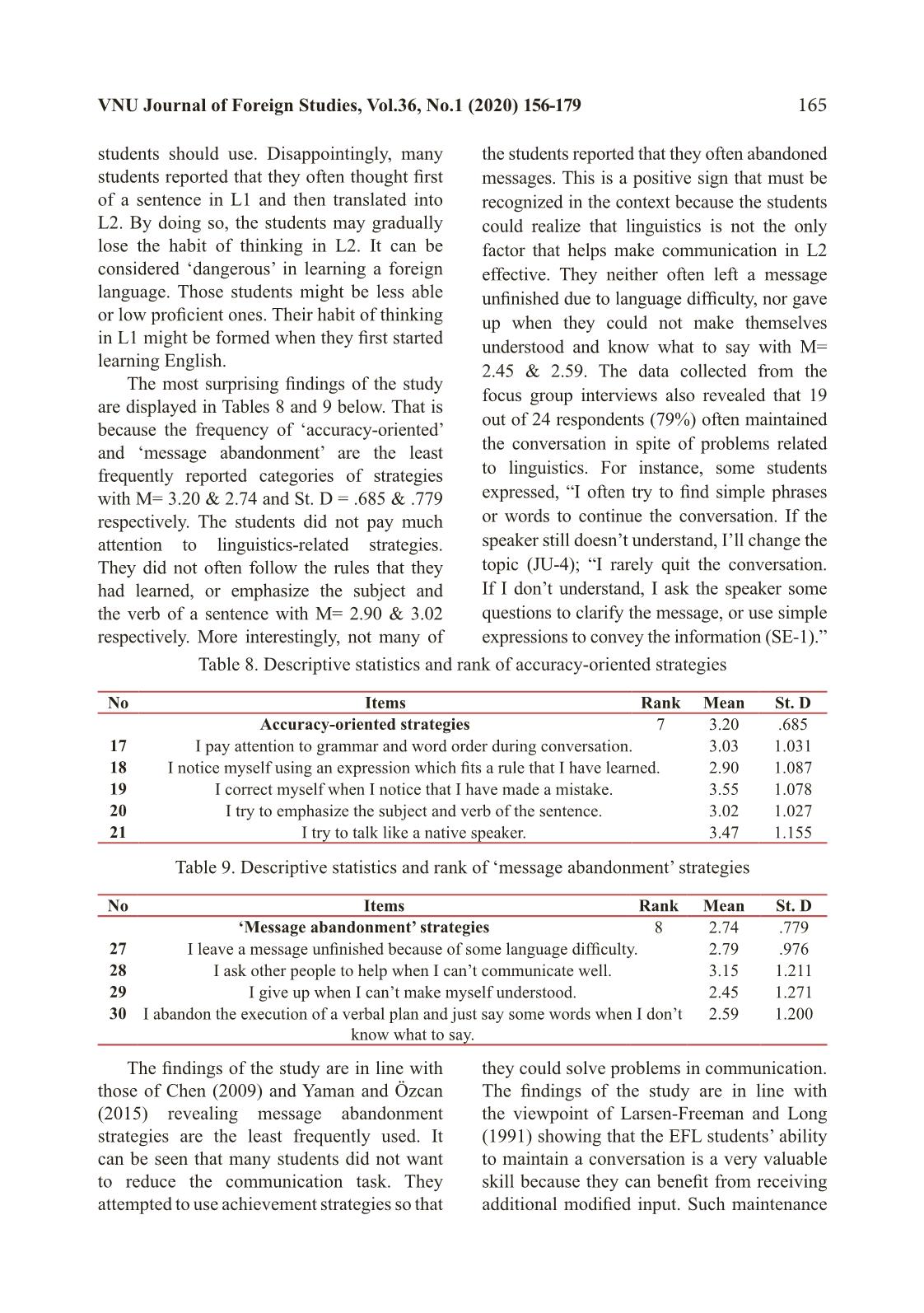
Trang 10
Tải về để xem bản đầy đủ
Tóm tắt nội dung tài liệu: Strategies used by undergraduate Englishmajored students in oral communication
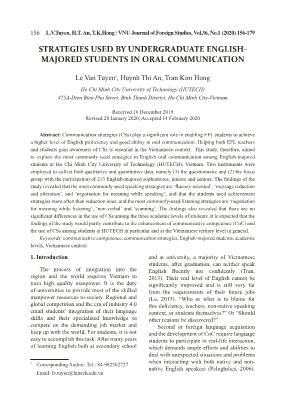
156 L.V.Tuyen, H.T. An, T.K.Hong / VNU Journal of Foreign Studies, Vol.36, No.1 (2020) 156-179 STRATEGIES USED BY UNDERGRADUATE ENGLISH- MAJORED STUDENTS IN ORAL COMMUNICATION Le Van Tuyen*, Huynh Thi An, Tran Kim Hong Ho Chi Minh City University of Technology (HUTECH) 475A-Dien Bien Phu Street, Binh Thanh District, Ho Chi Minh City-Vietnam Received 16 December 2019 Revised 28 January 2020; Accepted 14 February 2020 Abstract: Communication strategies (CSs) play a significant role in enabling EFL students to achieve a higher level of English proficiency and good ability in oral communication. Helping both EFL teachers and students gain awareness of CSs is essential in the Vietnamese context. This study, therefore, aimed to explore the most commonly used strategies in English oral communication among English-majored students at Ho Chi Minh City University of Technology (HUTECH), Vietnam. Two instruments were employed to collect both qualitative and quantitative data, namely (1) the questionnaire and (2) the focus group with the participation of 213 English-majored sophomores, juniors and seniors. The findings of the study revealed that the most commonly-used speaking strategies are ‘fluency-oriented’, ‘message reduction and alteration’, and ‘negotiation for meaning while speaking’, and that the students used achievement strategies more often than reduction ones; and the most commonly-used listening strategies are ‘negotiation for meaning while listening’, ‘non-verbal’ and ‘scanning’. The findings also revealed that there are no significant differences in the use of CSs among the three academic levels of students. It is expected that the findings of the study would partly contribute to the enhancement of communicative competence (CoC) and the use of CSs among students at HUTECH in particular and at the Vietnamese tertiary level in general. Keywords: communicative competence, communication strategies, English-majored students, academic levels, Vietnamese context 1. Introduction 1The process of integration into the region and the world requires Vietnam to train high quality manpower. It is the duty of universities to provide most of the skilled manpower resources to society. Regional and global competition and the era of industry 4.0 entail students’ integration of their language skills and their specialized knowledge to compete on the demanding job market and keep up with the world. For students, it is not easy to accomplish this task. After many years of learning English both at secondary school * Corresponding Author: Tel.: 84-982362727 Email: lv.tuyen@hutech.edu.vn and at university, a majority of Vietnamese students, after graduation, can neither speak English fluently nor confidently (Tran, 2013). Their real level of English cannot be significantly improved and is still very far from the requirements of their future jobs (Le, 2013). “Who or what is to blame for this deficiency, teachers, non-native speaking context, or students themselves?” Or “Should other reasons be discovered?” Second or foreign language acquisition and the development of CoC require language students to participate in real-life interaction, which demands ample efforts and abilities to deal with unexpected situations and problems when interacting with both native and non- native English speakers (Peloghities, 2006). 157VNU Journal of Foreign Studies, Vol.36, No.1 (2020) 156-179 Thus, CSs play an integral part for students to cope with speaking and listening problems in the process of language acquisition. Nevertheless, most of the EFL students in Vietnam are not aware of the importance of using CSs; and their use of strategies in English oral communication is still limited (Le, 2018). Therefore, raising students’ awareness of the use of CSs is a must. According to Stern (1983), to have in- depth understanding of the use of CSs, studies should be conducted in different contexts, under different language learning conditions, and at different levels of language proficiency. So far CSs seem to have been a major area of investigation and exploration in the field of second or foreign language acquisition. That is because these strategies do not only help overcome problems but they can also significantly contribute to improving and building up strategic competence (SC) for English users (Ounis, 2016); especially, different learning contexts may have different impact on students’ use of CSs and their communicative performance (Kitajima, 1997). Nonetheless, a review of the relevant literature revealed that studies with respect to the use of CSs by Vietnamese tertiary students are quite few. To fill this gap, this study aims to investigate the use of strategies in oral communication by English-majored students at tertiary level of Vietnam. More specifically, it attempts (1) to explore the common strategies used to deal with speaking and listening skills among English-majored students at Ho Chi Minh City University of Technology (HUTECH); and (2) to examine whether there are significant differences in the use of CSs among three academic levels, namely sophomores, juniors, and seniors. Based on the objectives, the current study attempted to answer the two following questions: 1. What are the most common strategies used in oral communication by English- majored students at HUTECH? 2. What are the differences in the use of strategies in oral communication among three academic levels of English-majored students at HUTECH? 2. Literature review 2.1. Strategic competence Strategic competence is one of the components of CoC which was proposed explicitly by Canale and Swain (1980) and Bachman (1990) or implicitly by Hymes (1967), CEFR (2001) and Littlewood (2011). Accordingly, all the components of CoC mention both knowledge of ... Chinese EFL learners. Chinese Journal of Applied Linguistics, 33(3), 110-125. Mirzaei, A., & Heidari, N. (2012). Exploring the use of oral communication strategies by (non) fluent L2 speakers. The Journal of Asia TEFL, 9(3),131-156. Nakatani, Y. (2006). Developing an oral communication strategy inventory. The Modern Language Journal, 90(2), 151-168. Nakatani, Y. (2010). Identifying strategies that facilitate EFL learners’ oral communication: A classroom study using multiple data collection procedures. Modern Language Journal, 94 (1), 116–136. Ounis, T. (2016). Exploring the use of oral communication strategies by high and low proficiency learners of English: Tunisian EFL students as a case study. International Journal of Humanities and Cultural Studies, 2 (1), 1077-1098. Peloghitis, J. (2006). Enhancing communication through the use of foreigner interviews. Journal of NELTA, 11(1-2), 47-51. Rababah, G. (2002). Second language communication strategies: Definitions, taxonomies, data elicitation methodology and teachability issues. Washington: US Educational Resources Information Center. Rababah, G. (2004). Strategic competence in an ELT syllabus. ITL. Review of Applied Linguistics. 145–165. Rababah, G., & Bulut, D. (2007), Compensatory strategies in Arabic as a second language. Poznan Studies in Contemporary Linguistics, 43(2), 83-106. Rastegar, M., & Goha, S. S. M. (2016). Communication strategies, attitude, and oral output of EFL learners: A study of relations. Open Journal of Modern Linguistics, 6, 401-419. Richards, J. C., & Schmidt. R.W. Language and communication. London: Longman. Sevki, K., & Oya, B. (2013). A comparative evaluation of pre-service English teachers’ coping strategies in oral communication. Training and Practice, 11(1-4), 107-124. Stam, G., & McCafferty, S.G. (2008). Gesture studies and second language acquisition: A review. In S.G. McCafferty & G. Stam (Eds). Gesture, second language acquisition and classroom research (pp. 3–24). New York: Routledge. Stern, H. H. (1983). Fundamental concepts of language teaching. Oxford: Oxford University Press. Tarone, E. (1980). Communication strategies, a foreigner talk and repair in interlanguage. Language Learning 30, 417–431. Tarone, E. (1981). Some thoughts on the notion of communication strategy. TESOL Quarterly, 15(3), 285–295. Tran, T. T. (2013). Factors affecting teaching and learning English in Vietnamese universities. The Internet Journal Language, Culture and Society, 38, 138-145. Willems, G. M. (1987). Communication strategies and their significance in foreign language teaching. System, 15(3), 351-364. Yaman, S., & Özcan, M. (2015). Oral communication strategies used by Turkish students learning English as a foreign language. In M. Pawlak & E. Waniek- Klimczak (Eds.). Issues in teaching, learning and testing speaking in a second language (pp.143-158). New York: Springer. Zulkurnain, N., & Kaur, S. (2014). Oral English communication difficulties and coping strategies of diploma of hotel management students at UiTM. 3L: The Southeast Asian Journal of English Language Studies, 20(3), 93–112. 176 L.V.Tuyen, H.T. An, T.K.Hong / VNU Journal of Foreign Studies, Vol.36, No.1 (2020) 156-179 CHIẾN LƯỢC GIAO TIẾP CỦA SINH VIÊN CHUYÊN NGÀNH TIẾNG ANH Lê Văn Tuyên, Huỳnh Thị An, Trần Kim Hồng Trường Đại học Công nghệ TP. Hồ Chí Minh (HUTECH) 475A Điện Biên Phủ, Phường 25 Quận Bình Thạnh-TP. Hồ Chí Minh Tóm tắt: Chiến lược giao tiếp đóng vai trò quan trọng trong quá trình hỗ trợ sinh viên học tiếng Anh nâng cao trình độ và khả năng giao tiếp, giúp giáo viên và sinh viên tiếng Anh nhận thức đầy đủ về những thủ thuật giao tiếp rất cần thiết trong môi trường giáo dục ngoại ngữ ở Việt Nam. Chính vì thế, mục đích của bài nghiên cứu này là khám phá những chiến lược được sử dụng phổ biến nhất trong giao tiếp bằng tiếng Anh của sinh viên trường Đại học Công nghệ Thành phố Hồ Chí Minh-Việt Nam. Nghiên cứu sử dụng cả hai phương pháp định tính và định lượng để thu thập dữ liệu, đó là (1) bảng câu hỏi khảo sát và (2) phỏng vấn theo nhóm. Tổng số 213 sinh viên năm 2, năm 3 và năm 4 chuyên Anh tham gia vào nghiên cứu. Kết quả của nghiên cứu cho thấy các chiến lược giao tiếp như ‘hướng đến sự lưu loát’, ‘giản lược và thay đổi’ và ‘thỏa hiệp về nghĩa khi nói’ được sinh viên dùng nhiều nhất khi nói tiếng Anh. Đối với kỹ năng nghe, sinh viên sử dụng nhiều nhất ba chiến lược, bao gồm: ‘thỏa hiệp về nghĩa khi nghe’, ‘lướt ý’ và ‘phi ngôn ngữ’. Ngoài ra, kết quả của nghiên cứu cũng cho thấy không có sự khác biệt trong cách sử dụng chiến lược giao tiếp bằng lời nói giữa sinh viên năm thứ 2, thứ 3 và thứ 4. Bài nghiên cứu hy vọng đóng góp phần nào đó vào quá trình cải thiện năng lưc giao tiếp và khả năng sử dụng những chiến lược giao tiếp để nâng cao kỹ năng tiếng Anh cho sinh viên Đại học HUTECH nói riêng và sinh viên đại học ở Việt Nam nói chung. Từ khóa: năng lực giao tiếp, chiến lược giao tiếp, sinh viên chuyên Anh, cấp lớp, bối cảnh Việt Nam APPENDICES APPENDIX A: Student questionnaire Dear students, We are conducting a study on oral communication strategies used by English-majored students at HUTECH. Could you please complete the three parts of the questionnaire? Your information provided for us will only be used for the purpose of research so please do not leave any item unanswered. Thank you very much. Part 1: Personal information 1. Your age: 2. Your gender:.. 3. Your academic year:.. Part 2: Use of speaking strategies In the table below there are 32 English oral communication strategies. How often do you use these strategies in learning? Please read them carefully and circle the responses 1-Never (N), 2-Rarely (R), 3-Sometimes (S), 4-Often (O), or 5-Always (A). 177VNU Journal of Foreign Studies, Vol.36, No.1 (2020) 156-179 No Items N R S O A Social affective strategies 1 I try to relax when I feel anxious. 1 2 3 4 5 2 I try to enjoy the conversation. 1 2 3 4 5 3 I try to give a good impression to the listener. 1 2 3 4 5 4 I actively encourage myself to express what I want to say. 1 2 3 4 5 5 I don’t mind taking risks even though I might make mistakes. 1 2 3 4 5 6 I try to use fillers when I cannot think of what to say. 1 2 3 4 5 Fluency-oriented strategies 7 I pay attention to my rhythm and intonation. 1 2 3 4 5 8 I pay attention to my pronunciation. 1 2 3 4 5 9 I pay attention to the conversational flow. 1 2 3 4 5 10 I change my way of saying things according to the context. 1 2 3 4 5 11 I take my time to express what I want to say. 1 2 3 4 5 12 I try to speak clearly and loudly to make myself heard. 1 2 3 4 5 ‘Negotiation for meaning while speaking’ strategies 13 I make comprehension checks to ensure the listener understands what I want to say. 1 2 3 4 5 14 I repeat what I want to say until the listener understands. 1 2 3 4 5 15 While speaking, I pay attention to the listener’s reaction to my speech. 1 2 3 4 5 16 I give examples if the listener doesn’t understand what I’m saying. 1 2 3 4 5 Accuracy-oriented strategies 17 I pay attention to grammar and word order during conversation. 1 2 3 4 5 18 I notice myself using an expression which fits a rule that I have learned. 1 2 3 4 5 19 I correct myself when I notice that I have made a mistake. 1 2 3 4 5 20 I try to emphasize the subject and verb of the sentence. 1 2 3 4 5 21 I try to talk like a native speaker. 1 2 3 4 5 ‘Message reduction and alteration’ strategies 22 I reduce the message and use simple expressions. 1 2 3 4 5 23 I use words which are familiar to me. 1 2 3 4 5 24 I replace the original message with another message because of feeling incapable of executing my original intent. 1 2 3 4 5 Non-verbal strategies while speaking 25 I try to make eye contact when I am talking. 1 2 3 4 5 26 I use gestures and facial expressions if I can’t express myself. 1 2 3 4 5 ‘Message abandonment’ strategies 27 I leave a message unfinished because of some language difficulty. 1 2 3 4 5 28 I ask other people to help when I can’t communicate well. 1 2 3 4 5 29 I give up when I can’t make myself understood. 1 2 3 4 5 30 I abandon the execution of a verbal plan and just say some words when I don’t know what to say. 1 2 3 4 5 ‘Attempt to think in English’ strategies 31 I think first of a sentence I already know in English and then try to change it to fit the situation. 1 2 3 4 5 32 I think of what I want to say in my native language and then construct the English sentence. 1 2 3 4 5 Part 3: Use of listening strategies 178 L.V.Tuyen, H.T. An, T.K.Hong / VNU Journal of Foreign Studies, Vol.36, No.1 (2020) 156-179 In the table below there are 26 strategies used to cope with difficulties in listening. How often do you use these strategies? Please read them carefully and circle the responses 1-Never (N), 2-Rarely (R), 3-Sometimes (S), 4-Often (O), or 5-Always (A). No Items N R S O A ‘Negotiation for meaning while listening’ strategies 1 I ask for repetition when I can’t understand what the speaker has said. 1 2 3 4 5 2 I make a clarification request when I am not sure what the speaker has said. 1 2 3 4 5 3 I ask the speaker to use easy words when I have difficulties in comprehension. 1 2 3 4 5 4 I ask the speaker to slow down when I can’t understand what the speaker has said. 1 2 3 4 5 5 I make clear to the speaker what I haven’t been able to understand. 1 2 3 4 5 Fluency-maintaining strategies 6 I pay attention to the speaker’s rhythm and intonation. 1 2 3 4 5 7 I send continuation signals to show my understanding in order to avoid communication gaps. 1 2 3 4 5 8 I use circumlocution to react to the speaker’s utterance when I don’t understand his/her intention well. 1 2 3 4 5 9 I ask the speaker to give an example when I am not sure what he/she has said. 1 2 3 4 5 10 I pay attention to the speaker’s pronunciation. 1 2 3 4 5 Scanning strategies 11 I pay attention to the subject and verb of the sentence when I listen. 1 2 3 4 5 12 I especially pay attention to the interrogative when I listen to WH-questions. 1 2 3 4 5 13 I pay attention to the first part of the sentence and guess the speaker’s intention. 1 2 3 4 5 14 I try to catch the speaker’s main point. 1 2 3 4 5 ‘Getting-the-gist’ strategies 15 I don’t mind if I can’t understand every single detail. 1 2 3 4 5 16 I anticipate what the speaker is going to say based on the context. 1 2 3 4 5 17 I guess the speaker’s intention based on what he/she has said so far. 1 2 3 4 5 18 I try to respond to the speaker even when I don’t understand him/her perfectly. 1 2 3 4 5 Non-verbal strategies while listening 19 I use gestures when I have difficulties in understanding. 1 2 3 4 5 20 I pay attention to the speaker’s eye-contact, facial expression and gestures. 1 2 3 4 5 ‘Less-active-listener’ strategies 21 I try to translate into native language little by little to understand what the speaker has said. 1 2 3 4 5 22 I only focus on familiar expressions. 1 2 3 4 5 Word-oriented strategies 23 I pay attention to the words which the speaker slows down or emphasizes. 1 2 3 4 5 24 I guess the speaker’s intention by picking up familiar words. 1 2 3 4 5 25 I try to catch every word that the speaker uses. 1 2 3 4 5 26 I pay attention to the first word to judge whether it is an interrogative sentence or not. 1 2 3 4 5 179VNU Journal of Foreign Studies, Vol.36, No.1 (2020) 156-179 APPENDIX B: Questions for focus group interviews 1. What problems do you often cope with when you speak English to someone inside or outside the classroom? 2. How do you feel whenever you start to speak English to someone? 3. What do you often pay attention to when you speak English to someone (e.g. pronunciation, vocabulary, or grammar)? 4. How do you often speak English? For example, do you speak slowly, quickly, softly or loudly? Do you try to speak as a native speaker? 5. What kinds of expressions do you use when you speak to someone? For example, do you use complex or simple expressions, familiar words or difficult words to express ideas? 6. What do you do if you speak to someone but he/she seems not to understand what you say? 7. What do you often do if you don’t know how to express your ideas? For example, do you use gestures and facial expressions, get eye contact or look away? 8. What will you do if you can’t make yourself understood? For example, do you just say some simple words and stop talking, or always try to keep the conversation? 9. Do you often think of what you want to say in Vietnamese first and then make up the English sentence? 10. What problems do you often cope with when you listen to someone speaking English? 11. What do you ask the speaker to do when you don’t understand what he/she says? For example, do you ask him or her to clarify the meaning, use easy words, speak slowly or repeat words? 12. What factors of the speaker do you often pay attention to when you listen to her/him? For example, do you pay attention to rhythm, intonation, pronunciation, gestures, intention, main points? Do you pay attention to the verb, subject, or types of questions? 13. Do you try to guess what the speaker is saying based on the context or his/her attention? 14. What do you often do when you understand a little about what the speaker says? For example, do you stop talking? 15. What do you do to show that you don’t understand what the speaker says? For example, do you use gestures, facial expressions, eye-contact, or translate what you hear into Vietnamese little by little? 16. What do you often pay attention when listening to someone speaking English? For example, do you concentrate on familiar words, sentences, types of questions which the speaker emphasizes or do you try to catch every word?
File đính kèm:
 strategies_used_by_undergraduate_englishmajored_students_in.pdf
strategies_used_by_undergraduate_englishmajored_students_in.pdf

